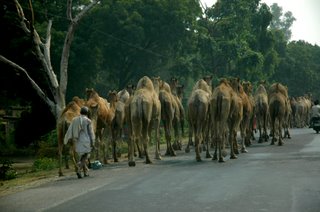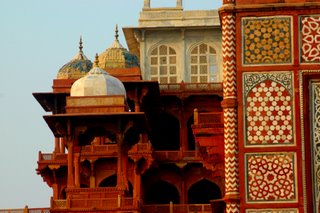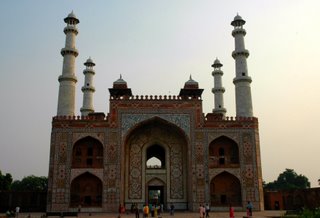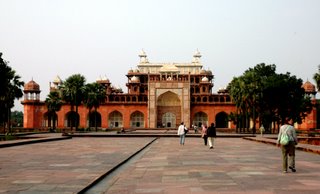Agra and Sikandra







The Mahabharat mentions Agrabana -- Forward Forest -- the likely origin of the name Agra. Looking out over the vast doab chequered with smallholding fields, it is difficult to appreciate that much of North India was heavily forested 4000 years ago, and that a frontier had to be tamed for settlement -- displacing the aboriginal woods-dwelling rakshashas and dasas, torching forests (such as Agni swallowing Khandava), painstakingly uprooting the stumps by hand or with first bronze and then iron implements, removing rocks, digging wells. Thus did settlements spread from Indraprastha to Ayodhya, to Mithila, to Magadha, to Pataliputra, Lakshmanavati and Suvarnagram. The process of wresting bounty from the earth and sons from the wombs of women first threw up gods, then heros, then kings and now there are only men striding ahead of their camels and slender brilliantly-wrapped women in the baking dust.
Claudius Ptolemius (Ptolemy the geographer) is the first to locate Agra by its current name in the 2nd century BCE, as a town east of a NE-SW mountain range named Apokopa or Poinai Theon. A curious name, for Poinai Theon in Greek means Punishment of the Gods. In the Mahabharata, in a listing of the tirthas Arbuda (heard as Apokopa by Ptolemy?) is listed as a place where a cleft was created in the earth due to the wrath of the gods. Once Nandini, the wish-fulfilling cow, was grazing by a lake here, and happened to fall in. The gods were incensed. They sent Arbuda, the celestial cobra, who brought a huge rock on his hood. Arbuda dropped the rock into the lake and it became Arbudachala or Arbuda's Immobile (Mt. Abu). The water from the lake was displaced and a cleft was left in the place, so Nandini was able to amble out. The sage Vasistha, who built an ashram near the cleft with a watchful view of the exposed netherworld, is believed to have performed a sacrifice which led to the birth of four agnikula (born from fire) Rajput warrior clans to protect the earth from demons. To the east of this range (i.e. the Aravallis) is Ptolemy's Agra. For more scholarly discussion on this see Notes on Ptolemy by J. Ph. Vogel, Bulletin of the School of Oriental and African Studies, University of London, Vol. 13, No. 1 (1949.)
Agra was fortified by Rajput kings such as Raja Badal Singh (1475), and, after their defeat, by the Sultanate. Sikandar Lodhi made it the capital of his empire and laid out the modern city, in the process giving his name to Sikandra. After the defeat of the Lodhis at Panipat, Babur infused cultural practices from Persia and Ferghana into the doab -- laying out formal gardens, minars, deer parks, partridgeries, melon fields and vines. For the next few hundred years Agra witnessed the rise of the pomp and pageantry of three of the 'Great Mughals' -- Akbar, Jahangir and Shahjahan -- all of whom lavished on the city their considerable imperial patronage.
Sikandra is the location of Akbar's tomb, begun by him and completed by his son Jahangir. The gateway is a variation on the Buland Darwaza in nearby Fatehpur Sikri. Endangered Chinkara (black buck) graze and enraged langurs chase each others' tails in the enclosed garden. Inside the bare mausoleum a sad-eyed employee of the ASI sits on the grave of Jalal-ud-din Mohammad The Great, yodeling into the cavernous dome to entertain tourists with an echo, subsequently holding out his hand for 'saheb das rupiya.'


1 Comments:
best site
Post a Comment
<< Home